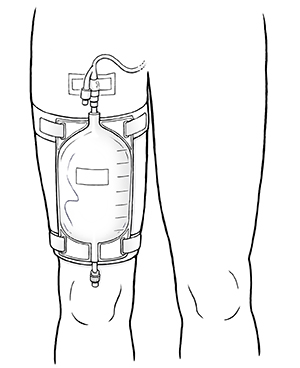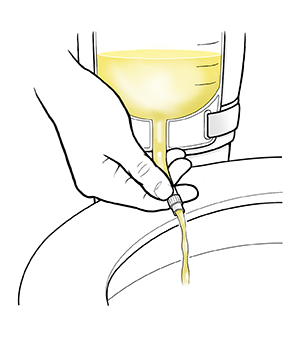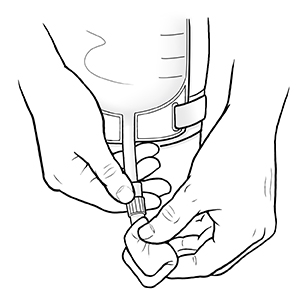Discharge Instructions: Caring for Your Leg Bag
You are going home with a urinary catheter and collection device (drainage bag) in place. One type of collection device is called a leg bag. This is a smaller drainage bag that you can wear on your leg to collect urine during the day. The bag can fit under your clothing. You can move around with greater ease when using a leg bag instead of a larger collection bag.
You were shown how to care for your catheter in the hospital. This sheet will help you remember those steps when you are at home.

Home care
-
Wash your hands thoroughly before and after you care for your catheter or collection device.
-
Gather your supplies:
-
Alcohol wipes
-
Soap and water
-
Towel and washcloth
-
Leg strap and leg bag
-
Use soap and water to wash the area where your catheter enters your body. Rinse well.
-
Secure the bag holder to your leg:
-
Put the leg band high on your thigh with the product label pointing away from your leg.
-
Stretch the leg band in place and fasten.
-
Place the catheter tubing over the bag and secure it. You may secure it with a Velcro tab or other method, depending on the product you use. Be sure to leave enough loop in the catheter above the leg band so you won't pull on the tube.
-
Every 4 to 6 hours, reposition the band. This will prevent pressure from the elastic on your leg. You can do this by changing the bag to the other leg or by raising or lowering the leg band.
-
Wash the band as often as needed. You can hand wash and dry the leg band.
-
Place the bag in the bag holder.
-
Clean the urine bag end of the catheter and your catheter port with an alcohol wipe.
-
Place a towel under the bag and port to keep urine from dripping onto your leg.
-
Before connecting the outlet valve at the bottom of the bag to the catheter, make sure that it is firmly closed. Flip the valve up toward the bag. It needs to snap firmly in place. Don't tug on the tubing. Be gentle.
-
Attach the urine bag to the end of the catheter. Insert the connector snugly into the catheter port. You can prevent dribbling urine by bending the catheter tubing just below the tip and holding it while you disconnect it from the catheter. Be careful to keep the tip clean while connecting the leg bag tubing to the catheter. This keeps germs from getting into the system.
-
Drain the bag when it's full. To drain the bag, flip the clamp downward. Direct the flexible outlet tube to control the flow of urine. You don’t have to disconnect the leg bag from the catheter to empty it. Raise your leg up to the edge of the toilet to reach the leg bag. Then you can empty the bag directly into the toilet. This way, you won’t need to bend over, which may be uncomfortable.


-
Keep the leg bag clean. Your healthcare provider may advise that you use a certain solution to clean the bag. Solutions that may be advised include:
-
Ask your healthcare provider how often you should clean your bag and what solution you should use to reduce odor and keep the bag free of germs.
-
Shake the solution a bit and allow it to remain in the bag for 30 minutes.
-
Drain the solution and rinse the bag with cold tap water.
-
Hang the bag to drain and air dry.
-
Remember to keep the drainage bag below the level of your bladder for correct drainage.
Follow-up
Make a follow-up appointment as directed by your healthcare provider.
When to call your healthcare provider
Call your healthcare provider right away if you have any of the following:
-
Redness, swelling, or warmth around the catheter entry site
-
Pus draining from your catheter entry site or into the catheter tubing and bag
-
Blood, clots, or floating debris in the urine
-
Nausea and vomiting
-
Shaking chills
-
Fever above 100.4°F ( 38°C), or as directed by your healthcare provider
-
Pain that is not eased by medicine
-
Catheter that falls out or is dislodged
Online Medical Reviewer:
Marc Greenstein MD
Online Medical Reviewer:
Raymond Kent Turley BSN MSN RN
Online Medical Reviewer:
Tennille Dozier RN BSN RDMS
Date Last Reviewed:
3/1/2022
© 2000-2024 The StayWell Company, LLC. All rights reserved. This information is not intended as a substitute for professional medical care. Always follow your healthcare professional's instructions.